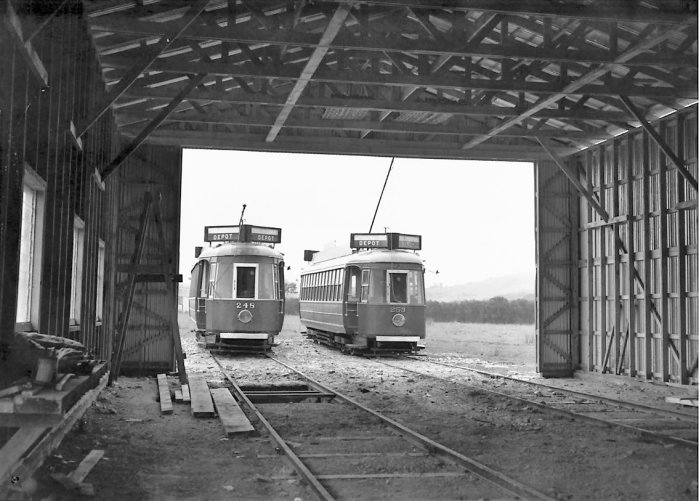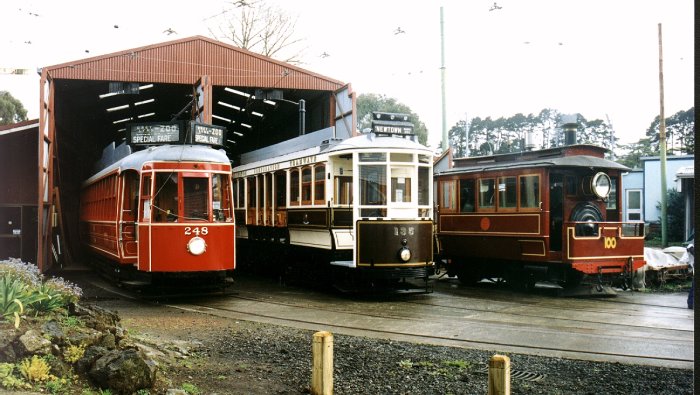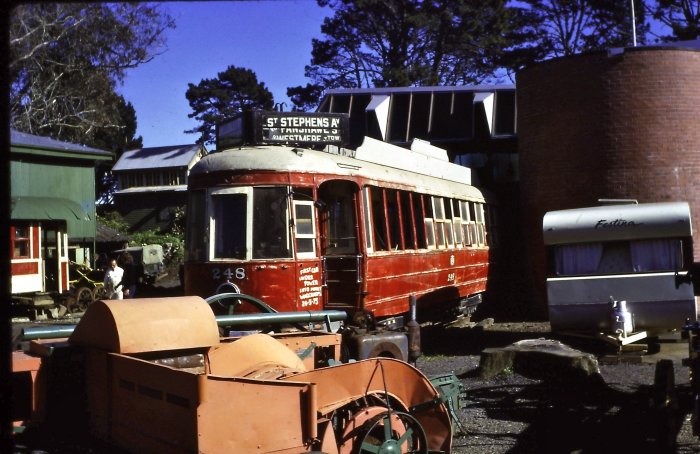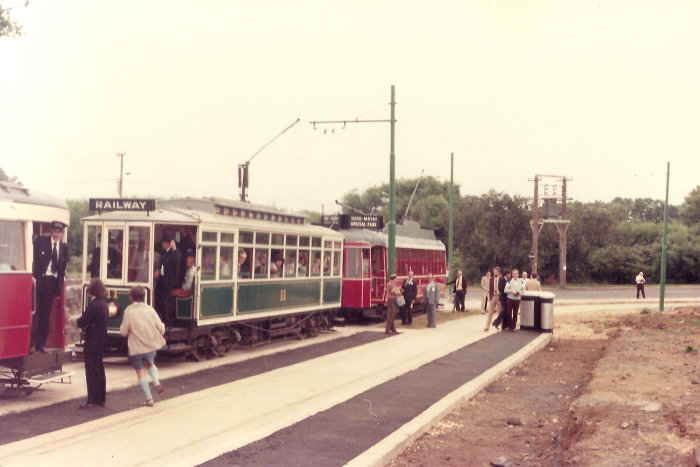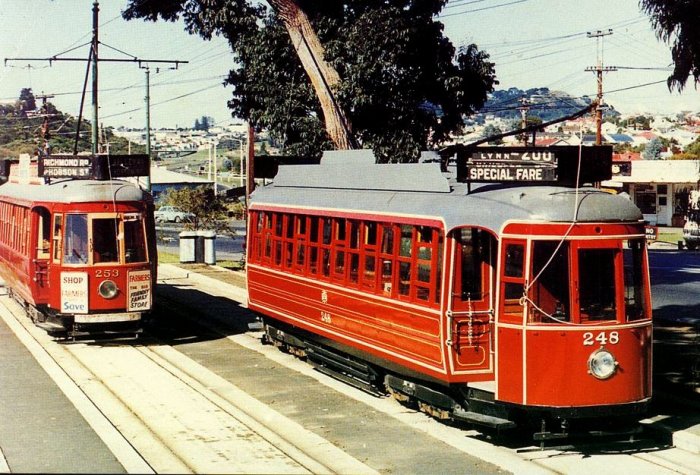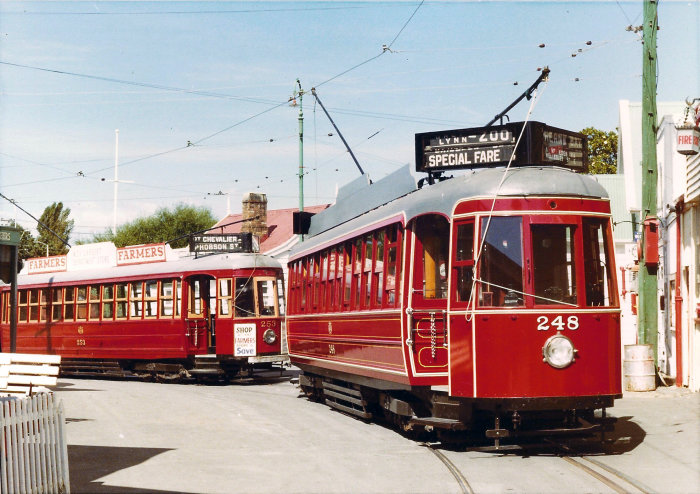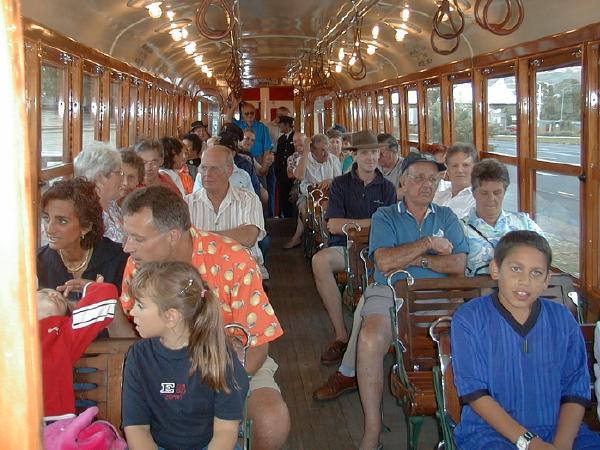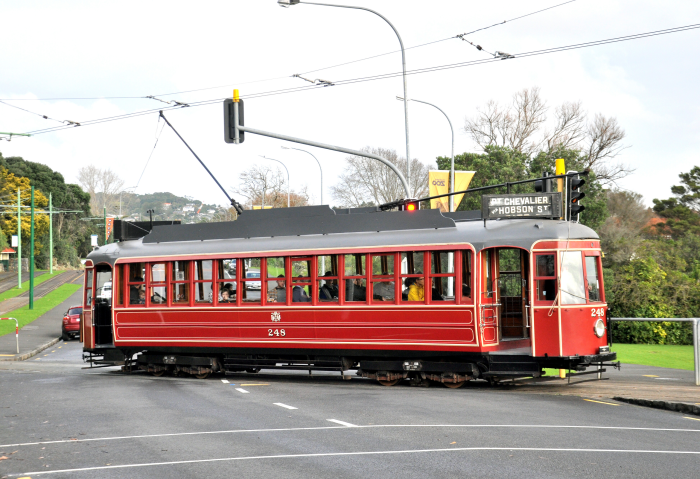Tram No. 248 a 1930s Auckland Streamliner

Tram 248 and its place in history
Since opening in 1964 MOTAT has operated a heritage tramway and preserves eight of Auckland’s retired tramcars in its collection. The tramway and collection are an important tribute to the city’s public transport heritage and an ever-popular part of the visitor experience at MOTAT. Auckland’s iconic 1930s streamliner is preserved and represented by tram 248, Auckland’s second-to-last tram up Queen Street in 1956 and classmate tram 253, known as the Queen Mary in the MOTAT Collection, but that is another story – read on to learn about tram 248’s history and preservation story.
The electric tramway is an important technology story in New Zealand’s transport history. Tramway networks were operated in numerous cities and towns around the country. Electric tramcars around Aotearoa were powered by a transformed and rectified source of electricity typically generated by a nearby substation. The tram’s trolley pole then collects power from a series of overhead wires in the network. The collected supply flows through either one or two of the tram’s circuit breakers, with each of these being used to prevent the electrical systems being overloaded. The power then flows into the controller, and it is this device that is used by the driver to distribute power to the motors, accelerating the tram. For cities around Aotearoa, this was a cleaner and faster alternative to animal-powered vehicles and became a well-patronaged form of public transport.
Auckland’s tramway system started in July of 1884 with an experimental run of a horse-drawn tram on Queen Street. [1] The first section was officially opened in August and ran from the intersection of Custom and Queen Streets to Ponsonby Reservoir. Eighteen years later an electrified service was opened for Auckland residents in 1902, privately operated by Auckland Electric Tramways Company Ltd (AET Co.). Thousands of people descended upon Auckland’s Queen Street to witness a tramcar operating without familiar, but much slower horses leading the way – it was a "phenomenon" of motive power as historian and photographer Graham Stewart puts it. [2]
![W. Beattie & Company. 01 Jan 1900. [Newton and Ponsonby horse-drawn tram], 14-0133. Walsh Memorial Library, The Museum of Transport and Technology (MOTAT).](https://images.ctfassets.net/mplktqcfflsk/2pg3Zkd2v8V0d4Jy68ArSc/0ce4ca03bcd57d8e84301b7a12b5fa6f/WPC_2014_0133.001_ACC.jpg?w=1302&h=800&fl=progressive&q=85&fm=jpg&bg=transparent)
W. Beattie & Company. 1 Jan 1900. [Newton and Ponsonby horse-drawn tram], 14-0133. Walsh Memorial Library, The Museum of Transport and Technology (MOTAT).
![Anderson, Martin, 1854-1932. "Cynicus" : The last car for Miramar. [Postcard. ca 1910]. Ref: Eph-POSTCARD-Drawer-Ellis-01. Alexander Turnbull Library, Wellington, New Zealand. The same postcard was created for Auckland’s Parnell service.](https://images.ctfassets.net/mplktqcfflsk/2TsJdzBdoyyZXfVWGrzay6/97884de65cfe84f0feaec524dc0c4062/nlnzimage.jpg?w=1080&h=686&fl=progressive&q=85&fm=jpg&bg=transparent)
Anderson, Martin, 1854-1932. "Cynicus" : The last car for Miramar. [Postcard. ca 1910]. Ref: Eph-POSTCARD-Drawer-Ellis-01. Alexander Turnbull Library, Wellington, New Zealand. The same postcard was created for Auckland’s Parnell service.
Tramways allow population growth
Tramway services grew in popularity around New Zealand in the first half of the twentieth century and postcards like the one above humorously captured their high usage. Over three decades from 1902, Auckland’s tramway network was expanded, eventually coming under local government control in 1919. The AET was also involved in property speculation. Routes were usually built through green field areas, then developers sold land and house packages, as people could now live further from the city centre and commute by electric tram, no longer limited by slower horse trams, horse buses or how far you could walk.
Auckland’s tramway operated until 1956 when it made way for trolley buses and the increasing use of private vehicles. Routes on the network went as far as to Onehunga Wharf when, in 1903, this was considered "rural" operation. Auckland’s tramway linked the Waitematā and Manukau harbours – necessary if one was travelling south via steamship in the years before the North Island Main Trunk Railway was opened. Onehunga Wharf was where the Union Steam Ship Company had started passenger express services from 1883. [3] It was the only coast to coast tramway in the world.
The earliest of Auckland’s electric tramcars were imported from Britain as kitsets and assembled in local workshops by AET. MOTAT’s preserved tram no. 11 is one of the first 43 kitsets imported from the Brush Electrical Engineering Company. Later tramcars had more locally built bodywork by coachbuilders like Cousins & Atkin (later D.S.C Cousins & Cousins). Preserved tram no. 89 is one such example, a double-truck saloon with a clerestory roof, the most populous type used on Auckland’s network (nos. 78 to 169 in the fleet).
![Graham Stewart. 1970s. [Preserved tram no. 11 with Golden Jubilee decorations at MOTAT. Tram 11 is seen here having its first test runs at the lower tram shelter - where the lower tram barn building now stands], PHO-2017-5.34. Walsh Memorial Library, The Museum of Transport and Technology (MOTAT).](https://images.ctfassets.net/mplktqcfflsk/3kGSgSyyItFXF2BLXCBz31/2734b1600a075dc3c70945a184125139/PHO-2017-5_34.001_ACC.jpg?w=1200&h=800&fl=progressive&q=85&fm=jpg&bg=transparent)
Graham Stewart. 1970s. [Preserved tram no. 11 with Golden Jubilee decorations at MOTAT. Tram 11 is seen here having its first test runs at the lower tram shelter - where the lower tram barn building now stands], PHO-2017-5.34. Walsh Memorial Library, The Museum of Transport and Technology (MOTAT).
Streamliners are the ultimate design
No. 248 is representative of the ultimate in tramcar design for Auckland – the “1937 – Streamliner type.” It is one of six trams constructed in the Auckland Transport Board Workshops in Royal Oak and fitted with trucks manufactured by the Electro Mechanical Braking Company Ltd. West Bromwich, UK, which featured advanced suspension and truck mounted brake cylinders. [4] The Streamliner class trams, which included the six EMB fitted trams, represent the final tramcar design that served the streets of Auckland and captures the later history and design features of the tramway. They are recognisable by the bulbous sides and rounded ends, although the class still retained the traditional wooden slatted seats and ratchet half-drop windows, much to the disappointment of the designer Victor Gibbon who had originally envisaged upholstered seats, modern windows and inset destination boxes.
No. 248 entered service on 8 July 1938. It featured modern braking systems and was fitted with 27-inch diameter wheels on, what was considered at the time, very modern four motor roller-bearing bogie trucks. This allowed the body to sit lower to the ground than the older trams. These were used overseas, such as in Glasgow, Scotland under modern double-deck trams.
During World War Two, 248, together with all Auckland trams, was modified for wartime conditions having silver destination boxes instead of black and silver bumpers. This is because of the blackouts that took hold in New Zealand during WW2; due to the very limited lighting in the streets, and that the trams only had the bare minimal lights on, the silver painted bumper made the end of the tram easier to spot and the destination boxes were likewise easier to see (their lights might not even have been turned on).
![Graham Stewart. Early 1950s. [Passengers boarding tram 248 on Point Chevalier, Wellesley Street West route], PHO-2020-19.455. Walsh Memorial Library, The Museum of Transport and Technology (MOTAT).](https://images.ctfassets.net/mplktqcfflsk/j7UXwICnhR3WPciOCB7ic/db0b8805e8a492f1372c414feda00de2/PHO-2020-19.455.jpg?w=1250&h=800&fl=progressive&q=85&fm=jpg&bg=transparent)
Graham Stewart. Early 1950s. [Passengers boarding tram 248 on Point Chevalier, Wellesley Street West route], PHO-2020-19.455. Walsh Memorial Library, The Museum of Transport and Technology (MOTAT).
Tram No. 248 gets a reprieve
No. 248 was in service until the very last day of trams running in Auckland, 29 December 1956, and took part in the commemorative Last Tram parade from Queen Street back to the Epsom Tram Depot to mark the end of the Auckland tramway system. It was the second-to-last tram in a parade of four, followed by Last Tram No.242. In June of 1957, No.248 was the very last passenger tram to turn a wheel in Auckland streets, when together with three counterparts, they made the journey from the Epsom Tram Depot down the road to the Manukau Road Tramway Workshops for dismantling and sale of the wooden bodies.
This would turn out to be the start of no. 248’s preservation story. Auckland Transport Board (ATB) had invited members of the newly formed Old Time Transport Preservation League to witness the final turning of the wheels. The group had already secured tram no. 253, the Queen Mary, which they were looking to preserve. Once incorporated, the League went on to secure other early items for what would later become the MOTAT Collection including, for example, Wanganui’s 1891 steam tram no.100; the Dunedin Mornington cable car trailer No.4, the sole survivor a disastrous depot fire in 1903; and the Orenstein & Koppel locomotive now being overhauled by MOTAT’s Western Springs Railway at MOTAT Motions Road.
During the visit with ATB, group member Mervyn "Merv" Sterling insisted on purchasing 248. Merv was initially thinking of using this as a playhouse for his children and wanted 248 because his uncle, Richard "Dick" Sterling, was the motorman first assigned this tram and it came to be regarded as"‘Dick’s tram. [5] Tram No. 248 was transported to Matakohe where Dick Sterling’s farm was and The Press reported in August 1957 that there were plans to offer a short heritage tram service if an electricity supply could be arranged.[6] Soon after, Merv Sterling donated the tram to the Old Time Transport Preservation League and, between July and August of 1957, both 253 and 248 were relocated to a custom-built shed that would become home for four years.
Around this time there were also several groups, including the League, lobbying to establish a transport and technology museum. Auckland Council had agreed to release land at Western Springs and that was the beginning of MOTAT, put rather simply. The League was disbanded on the establishment of MOTAT, once the trams they had acquired from Wellington had arrived at Western Springs, and having fulfilled their purpose to secure important transport heritage objects and find a site for the public to enjoy these displays.
MOTAT gains an iconic streamliner
In 1964, Tram 248 made its way down from Matakohe to MOTAT and was preserved as a static object in the museum’s early years. In 1967, track and infrastructure was completed for the museum’s tramway. The tramway officially opened on 16 December 1967 and opening speeches were made by the Mayor of Auckland and Minister of Transport – it was a milestone in the museum’s early history. The line length was 321 metres. [7] At first, only two trams were initially required to operate this experience, "Queen Mary" no. 253 and Wellington "Fiducia" no. 257, with 248 continuing to be a preserved static object for the meantime. Wellington works car no. 301 would occasionally be operated on special occasions.
From the late 1970s, 248 was restored to its "as built" 1938 livery of Carnation Red and Transport Ivory with black lining out. It was made operational to coincide with the extension of the museum’s tramway, which now required an additional passenger car for the service. No. 248 was used for the opening occasion, travelling along Great North Road until the corner of Motions Road where the extension terminated. The tramway’s line length was now 729 metres.
This extension also coincided with MOTAT installing a Hackbridge step-down transformer and Hewittic mercury arc rectifier, formerly installed at the Dominion Road substation for the then retiring trolleybus system, having been operated by Auckland Electric Power Board. The mercury arc rectifier would now convert DC power exclusively for the Western Springs Tramway at MOTAT, which it has done now for 43 years.
The first restoration of 248 at MOTAT included an extensive amount of work, replacing what was no longer reusable and restoring workable components for service. This included:
Exterior recanvassing of the roof (roof timbers and roof interior panelling, mostly original.)
Replacing cab end steels.
Replacing all the side pillars, as most were cracked or rotten.
Restoration of the long kauri waist rails below the saloon windows.
New kauri windows were manufactured in Northland, a replacement set was made for 253 at the same time.
Patterns were cast and installed to replace the worn-out brass window tracks.
Seats were repaired, revarnished and restored.
Replacement of the interior kauri ply panels located between the floor and waist rail.
Cab frame timbers rebuilt.
Large, but cracked and rotting kauri side panelling was impossible to source by 1980, so was replaced by plywood panelling with hardboard glued on for ease of painting.
Replacement of the wiring circuits for lighting.
Maintaining original traction cabling.
Overhaul and tidy-up of the original EMB L5 trucks.
Controllers and other systems overhauled to varying degrees.
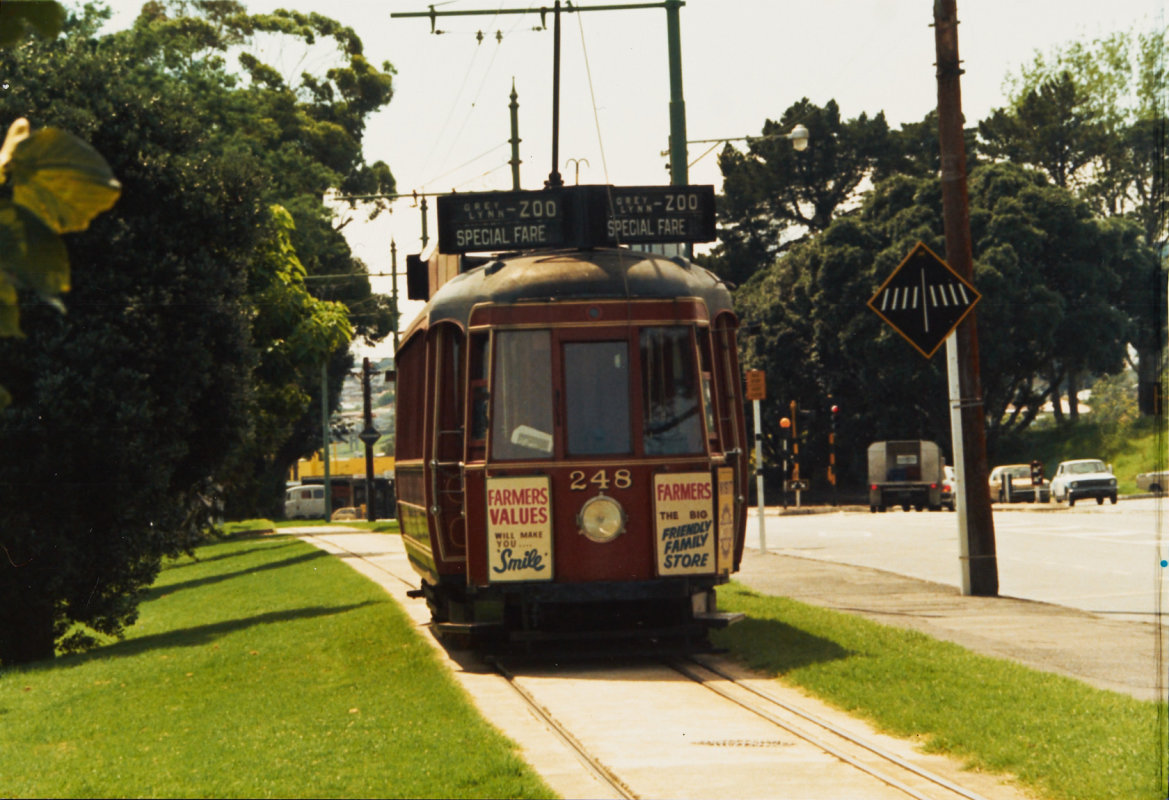
Image: Unknown photographer, courtesy of Noel Maurice. Circa 1981 – 2000. Tram 248 on Great North Road, 05-1993. Walsh Memorial Library, Museum of Transport and Technology (MOTAT)
No. 248 went on to have a second restoration between 1993 and 1996 which included repairs and replacement of weather-worn elements and to further strengthen structural elements of a tram now nearing 60 years since built. No. 248 is one of the heritage trams still operated on occasion by the MOTAT Tramway and can be viewed at Great North Road’s upper tram barn. Work on preserving 248 is continuous, for example, side panel repairs and repainting have been completed in recent years.
Specifications:
Bodywork: Auckland Transport Board's Royal Oak Workshops.
Trucks: Electro Mechanical Braking Company Ltd. West Bromwich, UK EMB L5 trucks.
Track Gauge: 4' 8½" (1435 mm) gauge.
Air wheel and track brakes and hand-operated wheel brakes. 27-inch diameter spoked wheels.� Owing to harsh and solid riding of 247 and 248, the ends of the EMB truck spring leaves were altered early in their service lives – reshuffled to form an overload type of spring and the truck frames strengthened.
Motors: 4 x Metropolitan Vickers MV109DY @ 35 HP
Controllers: General Electric GEK6 with Line Breaker Controller handle switch.
Published October 2023
Co-authored by Chelsea Renshaw, James Duncan and Megan Hutching using significance research for tram no. 248. Thank you to David Cawood for assisting with editing, image supply and providing restoration information.
End notes
[1] Graham Stewart. 1973. The end of the penny section: a history of urban transport in New Zealand, PUB-2017-47.10. Walsh Memorial Library, The Museum of Transport and Technology (MOTAT).
[2] Ibid.
[3] Ibid.
[4] David Cawood. 2018. Happy eightieth birthday for no. 248. In The Controller (no. 60).
[5] Harold Walton Stone et al. 1996. The Museum Makers, 01-04. Walsh Memorial Library, The Museum of Transport and Technology (MOTAT).
[6] Press, Volume XCVI, Issue 28367, 28 August 1957, Page 10. Accessed 27 June 2023: https://paperspast.natlib.govt.nz/newspapers/CHP19570828.2.78
[7] David Cawood. 2017. Chronology of the Western Springs Tramway 1957 – 2017. In The Controller.
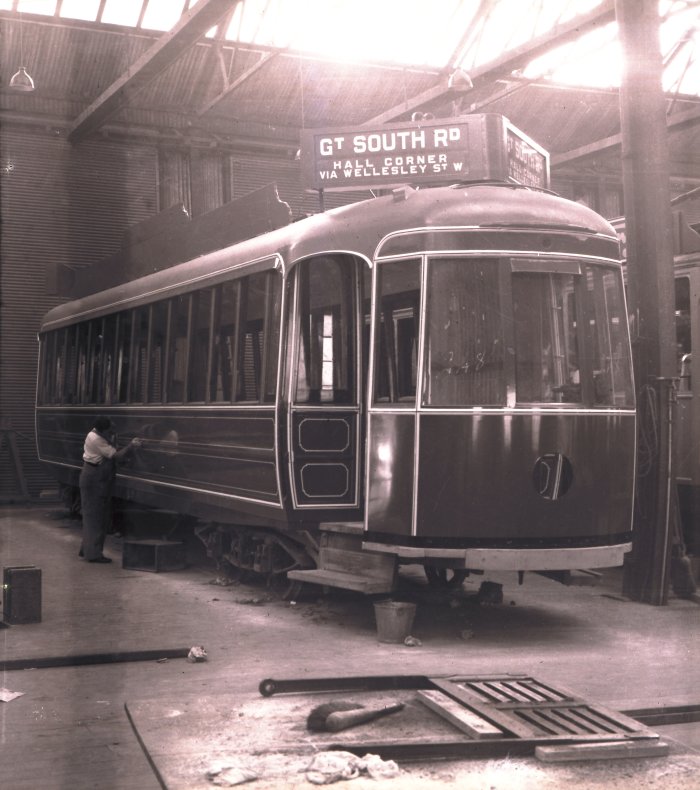
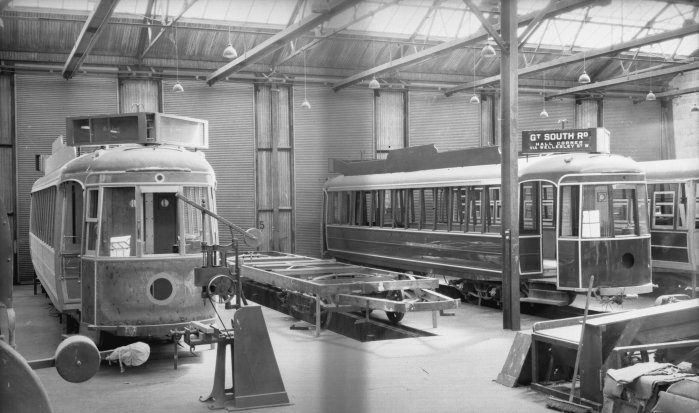
![Unknown photographer. 1938. [EMB L5 bogies being fitted to tram Streamliner No. 247 the first Auckland streamliner with curved sides], PHO-2017-5.30. Graham Stewart Collection. Walsh Memorial Library, The Museum of Transport and Technology (MOTAT).](https://images.ctfassets.net/mplktqcfflsk/3ISReRaANfoZvJxPnyknJa/33683a3292324479c0140c75a6094baa/PHO-2017-5_30.001_ACC.jpg?w=700&h=562&fl=progressive&q=85&fm=jpg&bg=transparent)

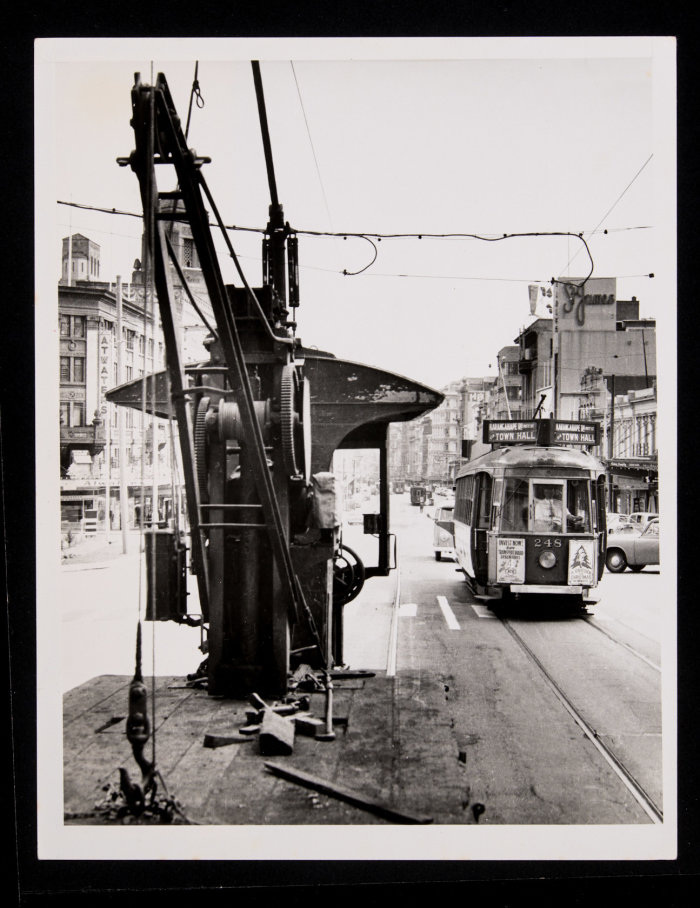
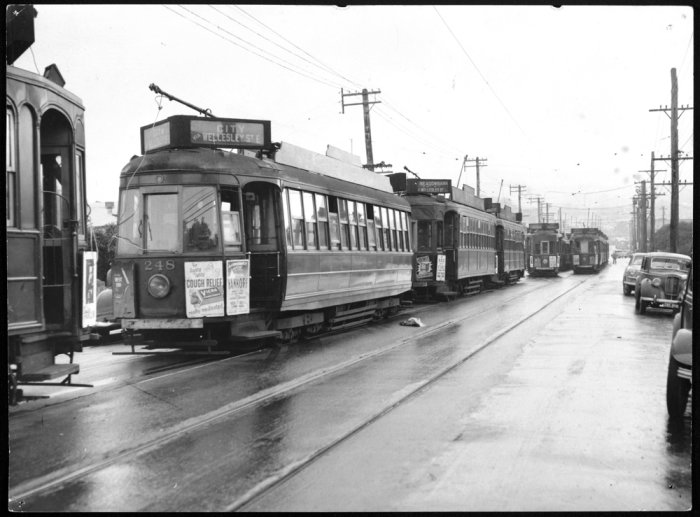
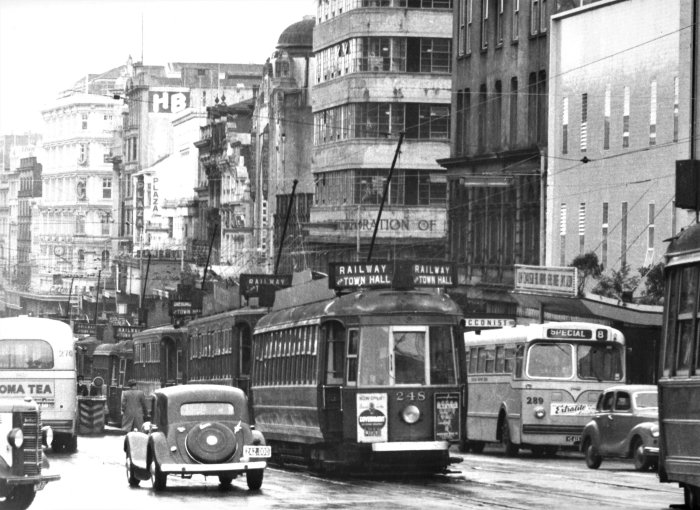
![Graham Stewart. 1954-1955. [Trams 181 and 248 in Manukau Road with the Epsom Tram sheds behind at the intersection of Balmoral Road and 248 turning out of Greenlane Road and bound for Onehunga]. PHO-2020-19.434. Walsh Memorial Library, The Museum of Transport and Technology (MOTAT).](https://images.ctfassets.net/mplktqcfflsk/2OJu1e1QLysKzLA77q0DhU/51a65691f3dc716578d04df1543e7c10/PHO-2020-19.434.jpg?w=700&h=534&fl=progressive&q=85&fm=jpg&bg=transparent)
![Graham Stewart. March 1953. [Tram 248 and B.U.T. trolleybus bus 29 at Westmere terminus in Garnet Road on the corner of Oban Road.] PHO-2020-19.262. Walsh Memorial Library, The Museum of Transport and Technology (MOTAT).](https://images.ctfassets.net/mplktqcfflsk/1bcENHVgHtNWmqfsSTUTGU/bd7357895c9a9d934bbbdcf62696b156/PHO-2020-19.262__1_.jpg?w=700&h=348&fl=progressive&q=85&fm=jpg&bg=transparent)
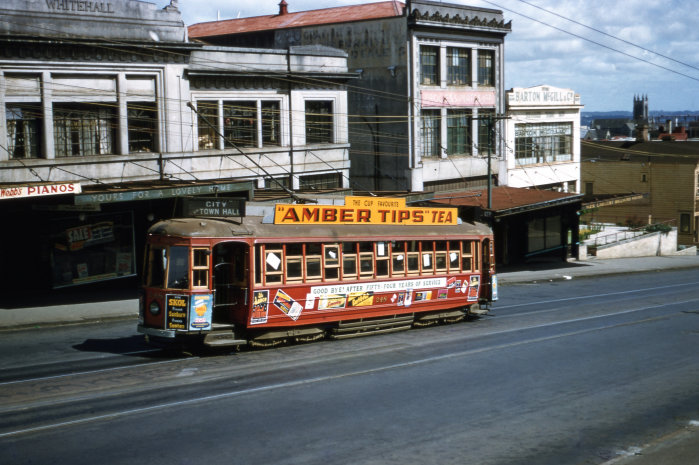
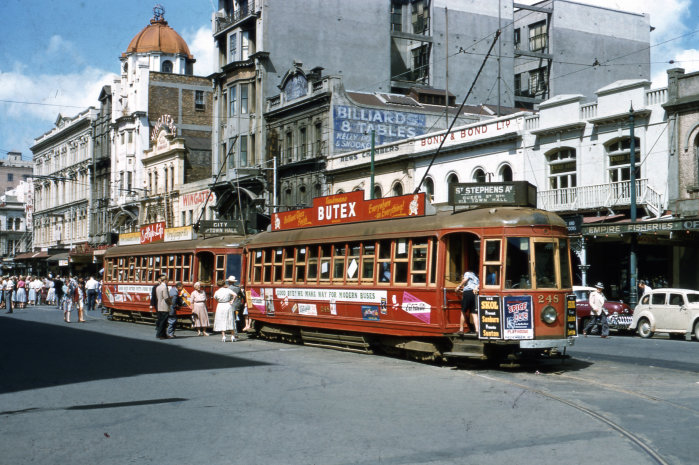
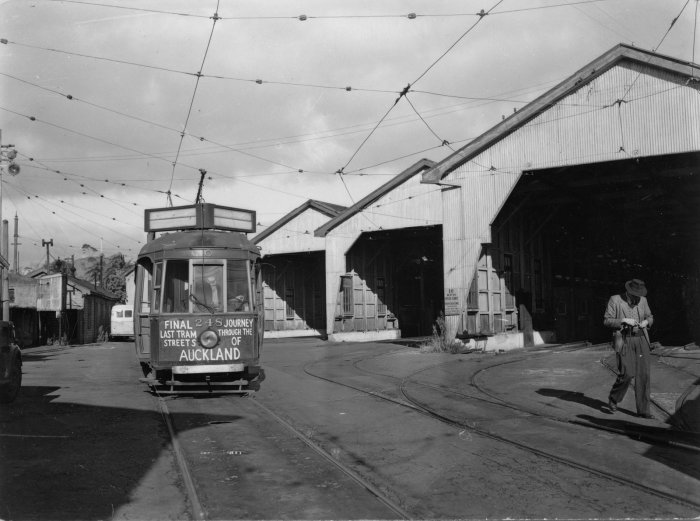
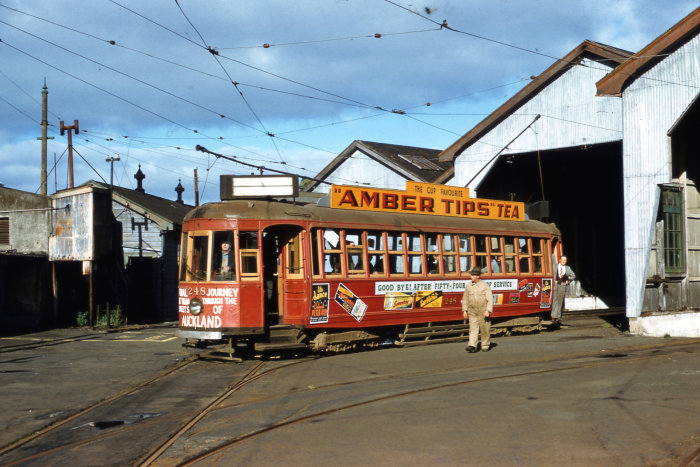
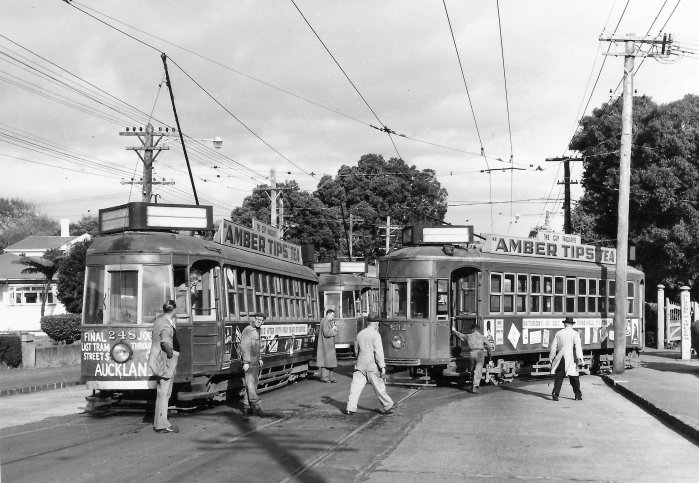

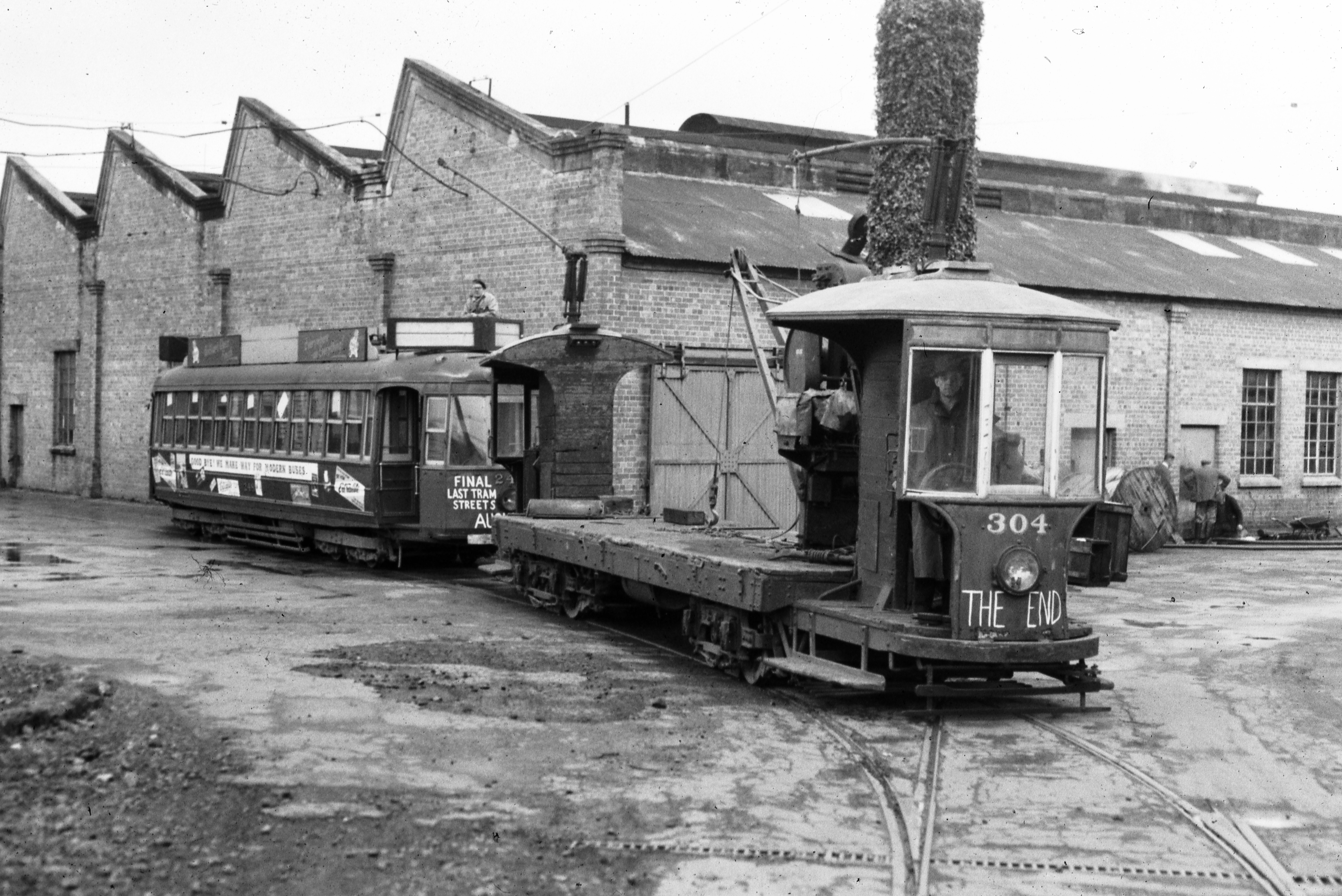
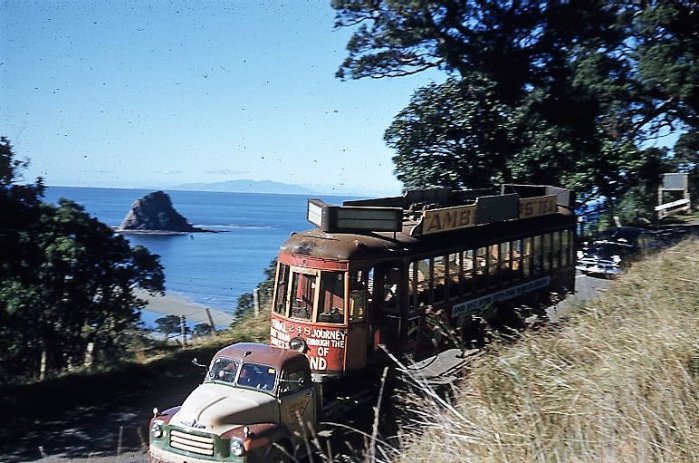
![Graham Stewart. Jul 1957. [Tram 248 on back of truck stuck in ditch on its way to Matakohe, Te Tai Tokerau.] PHO-2020-19.438. Walsh Memorial Library, The Museum of Transport and Technology (MOTAT).](https://images.ctfassets.net/mplktqcfflsk/6wploiJzRcebt1yTmaCkpE/2031f4184763b4561d44b0b138b72e02/PHO-2020-19.438.jpg?w=700&h=521&fl=progressive&q=85&fm=jpg&bg=transparent)
